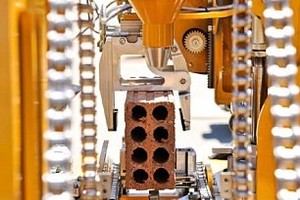
Meet the robot called Hadrian, developped by an australian investor can Hadrian lay 1‘000 bricks an hour an work 24/24 and could apparently build 150 homes a year.

The robot (pictured), called Hadrian, was developed by an Australian inventor. It can lay 1,000 bricks an hour and work around the clock, 24 hours a day. A robotic 'hand' lays the brick, and it can also apply mortar. It 3D scans its surroundings to work out exactly where to place bricks
Called Hadrian - named after the wall - the fully-automated robot was created by Australian inventor Mark Pivac, who founded Fastbrick Robotics. ‘People have been laying bricks for about 6,000 years and ever since the industrial revolution, they have tried to automate the bricklaying process,’ he told Perth Now. ‘We’re at a technological nexus where a few different technologies have got to the level where it’s now possible to do it, and that’s what we’ve done.’
For 6,000 years, bricklaying has remained largely the same - it still relies on slow, methodical placements by humans. But one inventor wants to turn the world of bricklaying on its head with his robot, which can out-perform even the most motivated of builders. Called Hadrian, it can lay 1,000 bricks and hour and work around the clock - and could apparently build 150 homes a year.


The robot has a boom 92ft (28 metres) long that is connected to its main body, seen left. At the end is a robotic ‘hand’ (right) that can grab bricks, pick them up, and place them down in sequence


The project, ten years in the making and with $7 million (£4.5 million) spent on it so far, would supposedly be able to create a house in just two days. It could work by itself 24 hours a day, 365 days a year, and although other aspects of the house would require human intervention, it is perhaps a sign of things to come
The project, ten years in the making and with $7 million (£4.5 million) spent on it so far, would supposedly be able to create a house in just two days.
It could work by itself 24 hours a day, 365 days a year, and although other aspects of the house would require human intervention, it is perhaps a sign of things to come in construction.
The product will be marketed first in Western Australia, before expanding to the rest of the country and ultimately the whole world.
Mr Pivac noted that he had 'nothing against bricklayers', and simply wanted to improve the process in which houses were made.
He says his robot could help attract younger people to the profession.
